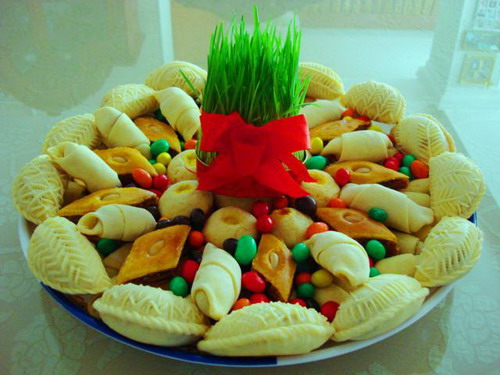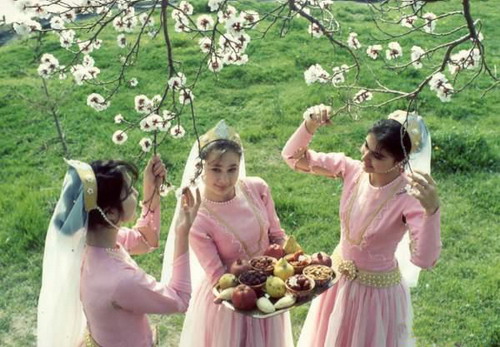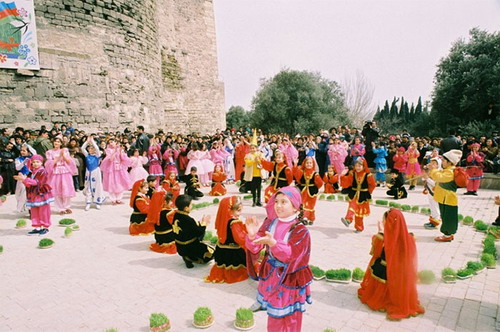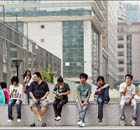Asia-Pacific
A little fire can inspire people at New Year's
By Mike Peters (China Daily/chinadaily.com.cn)
Updated: 2010-03-22 09:30
 |
Large Medium Small |

What we have today as Novruz has been celebrated for at least 3000 years and is deeply rooted in the traditions of Zoroastrian belief system. At its core, the Novruz festival celebrates the awakening of the natural life. This awakening symbolizes the triumph of good, winning against the evil forces of darkness that are represented by the Winter. Novruz is the point when the oppressive presence of the cold Winter finally begins to retrieve with the commencement of the lively and hopeful Spring. This symbolic and poetic change corresponds to the mathematical instance of the sun leaving the zodiac of Pisces and entering the zodiacal sign of Aries, also known as the Spring Equinox.
This Azerbaijani tradition is one of the most interesting. Novruz is associated with spring, start of agricultural activities, renewal of nature and warm days. This period being of great importance it caused many traditions and rites associated with magic, the cult of nature and earth, and belief in the perishing and reviving nature etc.

Virtually, celebrations began four weeks before the actual day of festivity. These four weeks - or, exactly four Wednesdays - were each devoted to one of the four elements and called correspondingly, although names varied from location to location. They were: Su Charhshanbasi (Water Wednesday), Od Charhshanbasi (Flame Wednesday), Torpaq Charhshanbasi (Earth Wednesday), Akhir Charhshanba (Last Wednesday).
According to folk beliefs, on Water Wednesday 'water renewed and dead-water came to stir'; the Flame Wednesday was believed the day of fire rebirth; on Earth Wednesday the earth revived. On the fourth (Last) Wednesday the wind opens tree buds and spring begins.
The most important of the Wednesdays was the Akhir Charhshanba (Last Wednesday before the vernal equinox) and most of important rites and ceremonies were delivered that day which concerned all the aspects of human life. Those rites were intended to provide welfare for an individual, his family and the community in general, to get rid of the old year's troubles and to avert a calamity.
Other very interesting traditions were associated with water and fire. As to water, its natural feature to wash the dirt away inhered its function as a means of circumcision and cleanup. Among such rites was jumping over a stream to purify from the sins of the year past. Another rite consisted of family members be sprinkling each other before going to bed on Last Wednesday.

Preparations for Novruz start long before the holiday. People do house cleaning, plant trees, make new dresses, paint eggs, make national pastries such as shakarbura, pakhlava and a great variety of national cuisine. Wheat is fried with kishmish (raisins) and govurga (nuts).
The holiday table on this day is very special. It is essential on this day to have seven dishes whose names begin with the letter "s". They are sumakh (a reddish-brown spice eaten with kebab), sud (milk), sirke (vinegar), samani (a special millet porridge), sabzi (greens) etc. Except for the listed dishes there should be a mirror, a candle and a painted egg on the table. All these have a symbolical significance: a candle means light or fire protecting a person from evil spirits. An egg and a mirror are necessary to mark the end of the old year and beginning of the first day of the new. According to beliefs, plenty of food and holiday dishes would provide sufficiency of these products in New Year. Some kinds of ritual food had magic meaning - like eggs which were believed to bear nucleus of new life. Azerbaijanis put the painted egg on the mirror. As soon as the egg moves the New Year begins. Everyone sitting at the table starts wishing a happy new year to each other. Usually, traditional Azeri plov of several sorts, sweat cookies and fruits were essential elements of holiday table.






